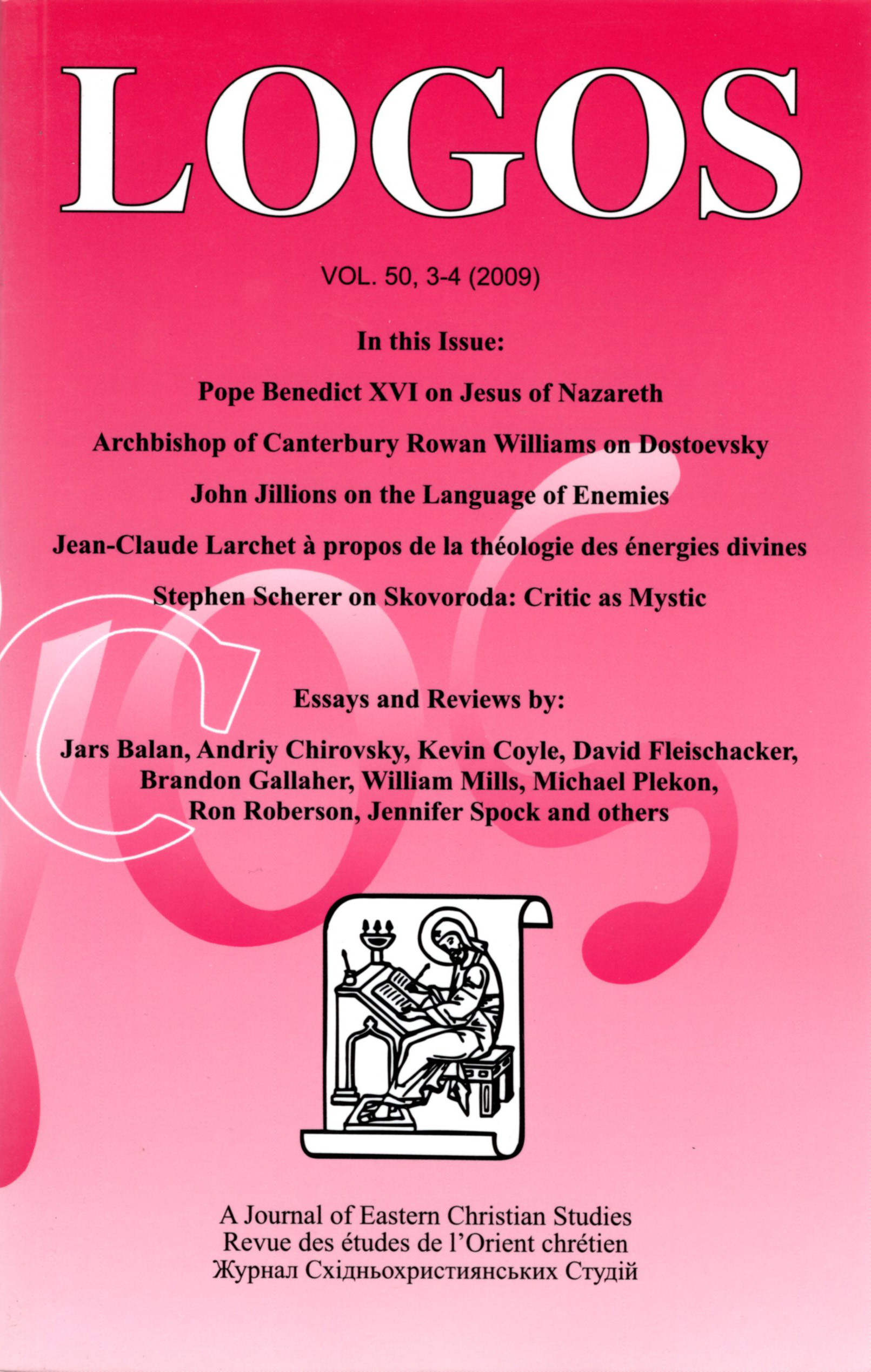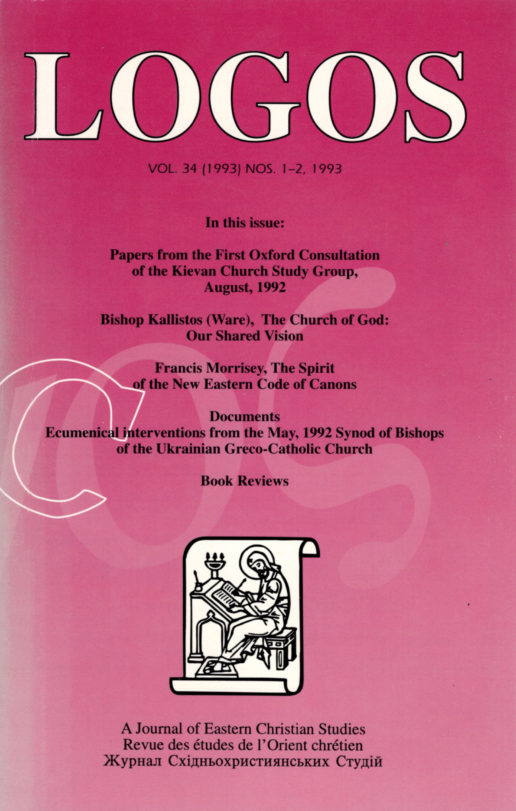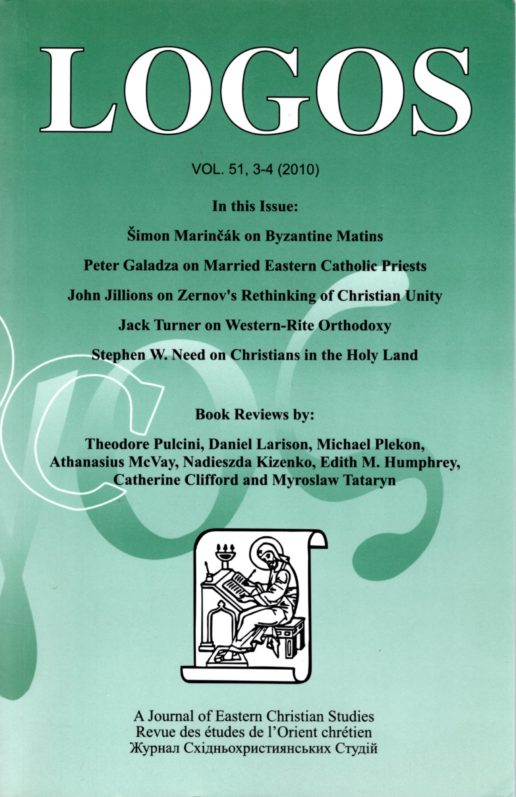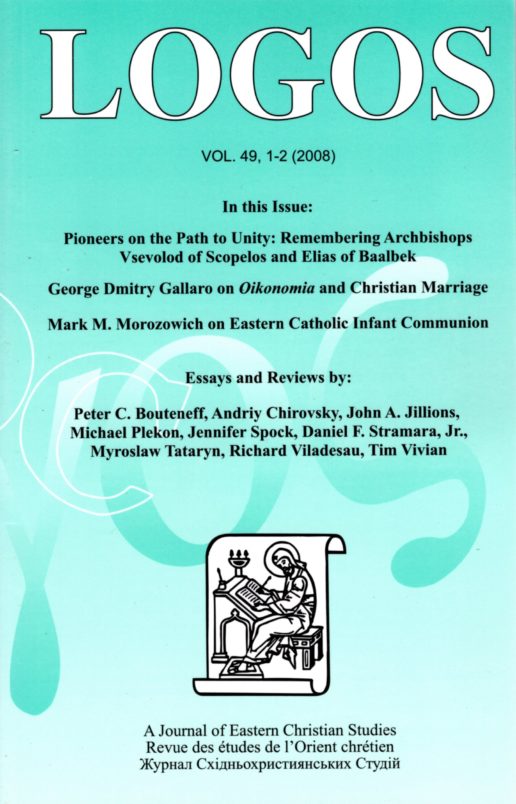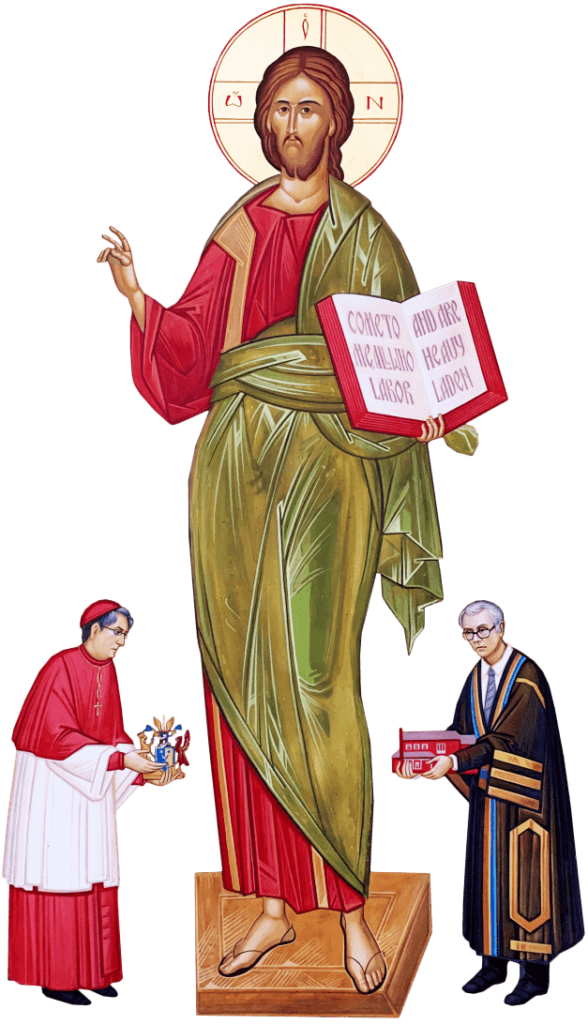Description
Table of Contents (PDF)
Editorial
Without Vision the People Perish: An Appreciation of the Metropolitan Andrey Sheptytsky Institute Foundation on its Twentieth Anniversary (PDF Open Access)
Andriy Chirovsky (263)
Articles
The Language Of Enemies (PDF sample)
John A. Jillions (271)
Abstract
Love of enemies is at the heart of Jesus’ teaching. Yet, the Scriptures and liturgy of the Orthodox Church, and the patristic literature on which they draw, are striking in their use of hostile and uncompromising language when speaking of enemies – both spiritual and actual or personal. This article reviews such language in the Bible; the writings of Justin Martyr, Cyril of Jerusalem, Gregory of Nyssa, John Chrysostom, and Theodore of Mopsuestia; and in liturgical services, Baptism especially. All of this has spawned a legacy of anathemas that the author seeks to analyze and understand through the work of Jaroslav Pelikan and Elaine Pagels. Having done that, the author, in part 2, informally surveys numerous Eastern Christians today to gauge their attitudes toward this language of enemies, and then gives special attention to those who see ecumenists as the most dangerous enemies of the Orthodox Church today. The author then introduces the work of conflict theorist Vern Redekop as a useful framework to understand this process and how “structures of blessing” can be created to overcome entrenched conflicts and “structures of violence.” The author argues that Redekop’s approach not only seems more congruent with the boundary crossing and peacemaking characteristic of Jesus, but also challenges today’s Orthodox to re-think their language and positions vis-à-vis their contemporary “enemies,” especially those ecumenists devoted to Christian unity.
Резюме
Любов до ворогів знаходиться в самому центрі вчення Ісуса. Водночас, Святе Письмо і літургія ПравославноїЦеркви, а також і базовані на них творіння отців Церкви послуговуються доволі різкою і навіть ворожою лексикою висловлюючись про ворогів – як духовних так і особистих.
Ця стаття звертається до таких висловлювань у Біблії, творіннях Юстиніяна Мученика, Кирила Єрусалимського, Григорія Нисського, Іоанна Златоустого і Теодора Моп-суетського а також богослужбових текстах, особливо таїн-ства Хрещення. Усі ці висловлювання породили цілий ряданатем, які автор намагається проаналізувати і зрозуміти за допомогою праць Ярослава Пелікана (Jaroslav Pelikan) та Елейн Пейджелс (Elaine Pagels). У другій частині статті автор проводить неформальні опитування численних схід-них християн з метою оцінки їхнього ставлення до цієї “мови ворогів” а потім звертає особливу увагу на тих, що вважають екуменістів найбільш небезпечними ворогами Православної Церкви сьогодні. Після цього автор звер-тається до наукового доробку теоретика конфліктології Верна Редекопа (Vern Redekop) щоб зрозуміти динаміку конфлікту і проаналізувати можливість створення і засто-сування “структур благословення” які б подолали застарілі конфлікти і наявні “структури ворожості”. Автор арґумен-товано стверджує, що позиція Редекопа не лише виглядає більш адекватною по відношенню до миротворчого ім-перативу Ісуса але й кидає виклик Православним хрис-тиянам сьогодення переглянути свої висловлювання і позиції щодо їхніх теперішніх “ворогів” і особливо екуме-ністів, відданих справі Християнської єдності.
La théologie des énergies divines: l’enjeu, les dificultés et les perspectives du dialogue entre catholiques et orthodoxes (PDF open access article)
Jean-Claude Larchet (369)
Abstract
Distinguishing between God’s “essence” and His “energies” was most famously done by Gregory Palamas, who would be opposed not only by Western theologians but also by Byzantine humanism. Palamite theology was polemically attacked by such modern Catholic patrologists as L. Allatius, D. Pétau, M. De Rubeis, M. Jugie, and S. Guichardon, and even today this theology is often dismissed as “heretical” even though more recent studies, such as those of G. Pelland, P. de Renczes, A. de Halleux, and E. Durand have demonstrated that “Palamism” has very ancient roots in patristic literature well before the fourteenth century. Orthodox patrologists (D. Staniloae, C. Kern, G. Florovsky, V. Lossky, and especially J. Meyendorff) have been just as polemical in their defence of Palamas as an integral part of Orthodox “identity.” The author suggests Catholic (and Protestant) hostility to Palamas may be explained by three factors (ignorance, excessive Augustinianism, or certain strands of Thomism), though the recent work of David Bradshaw has attempted to show that a fourth factor may be at work: different metaphysical systems in East and West. The debate about essence and energy touches on other Orthodox-Catholic debates, especially that of the filioque, which the author reviews by briefly surveying recent discussions as well as its treatment in Maximus the Confessor, Cyril of Alexandria, Augustine of Hippo, Athanasius of Alexandria, and Gregory of Cyprus. The author concludes that much work remains to be done to clarify the terms of the essence-energy debate, and absent such clarification “Palamism” may continue to be (or at least perceived to be) an impedimentum dirimens to Orthodox-Catholic unity.
Резюме
Найбільш відомим богословом, що описав різницю між Божественною “природою” та Її “енергіями” був Гри-горій Палама, в опозицію до якого виступили не лише західні богослови але й візантійська гуманістична тра-диція. Проти поглядів Григорія Палами полемічно висту-пили такі сучасні католицькі патрологи як L. Allatius, D. Pétau, M. De Rubeis, M. Jugie та S. Guichardon. Навіть сьо-годні його богословіє часто відкидають як “єретицьке” навіть на зважаючи на те, що недавні дослідження таких авторів як G. Pelland, P. de Renczes, A. de Halleux та E. Durand продемонстрували, що “Паламізм” має дуже давні корені в патристичній літературі ще задовго до 14 сто-ліття. Відповідь православних патристів (Д. Станілое, К. Керн, Г. Флоровський, В. Лосський і особливо І. Майен-дорф) на захист богословія Григорія Палами була настіль-ки ж полемічною бо захищалася невід’ємна частина пра-вославної “тотожності”. Автор пропонує розрізняти три джерела ворожості до Палами з боку католицьких (і проте-стантських) богословів: невігластво, надмірне августи-ніянство або (певні течії) томізму. Водночас, у нещодавній праці Дейвида Бредшав (David Bradshaw) робиться спроба запропонувати четверте джерело: відмінні метафізичні системи на Сході і на Заході. Дебати навколо сутності та енергій торкаються також інших дебатів між Право-славною та Католицькими Церквами зокрема стосовно “філіокве”. Автор звертається до нещодавніх публікацій на цю тему а також до творів Максима Сповідника, Кири-ла Олександрійського, Блаженного Августина, Атанасія Олександрійського та Григорія Кипрського. Автор дохо-дить висновку, що необхідно ще багато попрацювати для того щоб конкретизувати терміни, якими користуються сторони дебатів щодо Божественної сутності та енергій бо в протилежному разі “Паламізм” може залишатися уявним або реальним impedimentum dirimens у справі Православ-но-Католицької єдності.
Hryhoriy Skovoroda (1722–94): Critic as Mystic (PDF sample)
Stephen P. Scherer (387)
Abstract
The author demonstrates the connections between social criticism and mystical experience in the life of Skovoroda, who lived during the turbulent years when control over Ukraine passed from Poland to the Russian Empire, which, by 1780 under Catherine II, destroyed the last vestiges of Ukrainian independence. Following the ennoblement of the Cossack officer class and enserfment of the Ukrainian peasantry, Skovoroda reacted with oblique censure often expressed in poems whose texts the author analyzes not only for their social critique but also for their personal context and theological and spiritual underpinnings. Skovoroda was also a critic of the Orthodox Church and the corruption of monastic institutions, including the famous Kievan Caves Monastery. The peripatetic Skovoroda preferred always to guard his freedom and solitude in a life that could in some measure be called “monastic” but was unattached to any formal community. The central discovery of Skovoroda was that each one must discover for oneself what one’s nature is, and act in accordance with it. In so doing, one will at the same time discover not only a connection with universal human nature but also human happiness and ultimately divine communion mystically experienced. To understand this mystical communion with the divine energies, the author draws on Pseudo-Dionysius and others, and analyzes two central events treated by Skovoroda, viz., Christ’s transfiguration and resurrection.
Резюме
Автор демонструє зв’язок між соціяльною критикою та містичним досвідом у житті Сковороди, яке припало на буремні роки переходу України з-під влади Польщі під владу Російської імперії, яка вже до 1780 року (за Катери-ни ІІ) знищила самі залишки незалежності України. На-дання дворянства козацькій старшині та закріпачення ук-раїнського селянства було піддане завуальованій критиці у текстах Сковороди. Автор аналізує ці статті не лише на предмет соціяльної критики, але й на предмет особистого контексту, богословської та духовної тематики. Сковорода критикував також і Православну Церкву і корупцію мо-настирських інституцій включно із славетною Києво-Печерською Лаврою. Мандрівний філософ над усе цінив свою свободу і хоч в якомусь сенсі ми можемо назвати його монахом, він був вільним від будь-яких зобов’язань пов’язаних із формальною приналежністю до монастир-ської громади. Головною знахідкою Сковороди було те, що кожен повинен пізнати свою природу (себе) і діяти згідно з нею. Обравши такий шлях, людина не лише відчує зв’язок із універсальною людською природою але й здобу-де щастя і врешті решт зрозуміє і пізнає таємницю єднан-ня з Богом. Щоб зрозуміти це містичне єднання, автор посилається на Псевдо-Діонисія а також аналізує два цен-тральних аспекти віри: Христове Переображення і Воскре-сіння.
Notes, Essays, Lecture
Elements of a Vision for the Effective Synthesis of Universal Primacy and Conciliarity (PDF sample)
Peter Galadza (413)
An Eastern Catholic Approach to the Papacy (PDF sample)
Adam A.J. DeVille (419)
“The World as Sacrament” in Alexander Schmemann’s Vision (PDF sample)
Michael Plekon (429)
Cracking the Clerical Caste: Towards a Conciliar Church (PDF sample)
William C. Mills (441)
Married Priesthood: Some Theological “Resonances” (PDF sample)
Basilio Petrà (459)
Metaphysics and its Role in Christian Division: A Review Essay Discussing David Bradshaw, Aristotle East and West: Metaphysics and the Division of Christendom (PDF sample)
David Fleischacker (481)
Evagrius: Still Confounding, Still Profound (PDF sample)
Andriy Chirovsky (495)
Book Reviews
Ken Parry, ed., The Blackwell Companion to Eastern Christianity
Ron Roberson (509)
David N. Bell, Orthodoxy: Evolving Tradition
Adam A.J. DeVille (514)
Jesus of Nazareth by Joseph Ratzinger (Pope Benedict XVI)
Edith M. Humphrey (518)
Adrian Pabst and Christoph Schneider eds., Encounter Between Eastern Orthodoxy and Radical Orthodoxy: Transfiguring the World Through the Word
Michael Plekon (522)
Aristotle Papanikolaou and George E. Demacopoulos, eds., Orthodox Readings of Augustine
J. Kevin Coyle (526)
Jennifer Hedda, His Kingdom Come: Orthodox Pastorship and Social Activism in Revolutionary Russia
Jennifer Spock (530)
Kenneth F. Yossa, Common Heritage, Divided Communion: Advances of Inter-Orthodox Relations from Chalcedon to Chambésy
Adam A.J. DeVille (533)
Christos Yannaras, Orthodoxy and the West: Hellenic Self-Identity in the Modern Age, trans Peter Chamberas and Norman Russell
Brandon Gallaher (537)
Sergius Bulgakov, The Lamb of God, trans. Boris Jakim
Brandon Gallaher (543)
Sergius Bulgakov, Churchly Joy: Orthodox Devotions for the Church Year, trans. Boris Jakim
Marta Samokishyn (549)
Paul Laverdure, Redemption and Ritual: The Eastern-Rite Redemptorists of North America 1906–2006
Jars Balan (552)
Roman Cholij, Theodore the Stoudite: The Ordering of Holiness
William C. Mills (558)
William Riordan, The Divine Light: The Theology of Denys the Areopagite
Sarah Klitenic Wear (561)
Serhii Plokhy, Ukraine and Russia: Representations of the Past
Myroslaw Tataryn (564)
Lorenzo DiTommaso and Lucian Turcescu, eds. The Reception and Interpretation of the Bible in Late Antiquity: Proceedings of the Montréal Colloquium in Honour of Charles Kannengiesser, 11–13 October 2006
François Beyrouti (567)
Rowan Williams, Dostoevsky: Language, Faith, and Fiction
Vigen Guroian (570)
Briefly Noted (575)
Books Received (593)
Contributors (597)
Language: English, French, Ukrainian
Softcover: vi, 368 pages
Publisher: The Metropolitan Sheptytsky Institute of Eastern Christian Studies
ISSN: 0024-5895
Digital File: $16
Size: 2 MB
A link to the PDF file of this title will be sent to you. The PDF file is for your personal use only. You may not copy, share, publish, or sell the file. Protected by copyright of the Metropolitan Andrey Sheptytsky Institute of Eastern Christian Studies.

